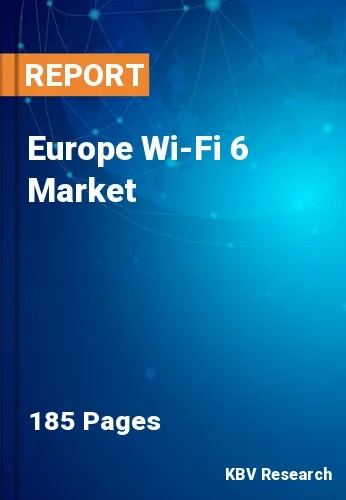The Europe Wi-Fi 6 Market would witness market growth of 26.5% CAGR during the forecast period (2023-2030).
During the projection period, the market is anticipated to be driven by the expanding need for an improved network, low latency, and bandwidth communications among organizations. Several industries, including corporates and industrials, need superior network connectivity due to the escalating volume of data traffic. Thus, it is anticipated that over the next seven years, Wi-Fi 6 installations will rise.
Wi-Fi 6 is the most effective solution for IoT connectivity, with data rates of up to 10 Gb/s with eight antennas, 160 MHz of bandwidth, and 1,024 QAM. Technology can be used to enhance mobile tablets, laptops, phones, and other devices that use a lot of power and have large batteries. One-antenna, 40 MHz, and 256 QAM devices with a capacity of 230 Mb/s are examples of less capable devices that can be used with it. This enables Wi-Fi 6 capabilities to be accessed by smaller devices. The maximum throughput of 802.11ac is approximately 3.5 Gbps, whereas Wi-Fi 6 has a maximum data transfer speed of 10 Gbps. Wi-Fi 6 also aims to reduce client power usage, boost client capacity, and lessen network congestion.
International Trade Administration reports that through the 2020 Smart City Model Projects Program, in which 32 selected projects (cities, inter-municipal consortiums, and counties) are funded with approximately EUR 350 million, the German government assists municipalities by financing the development and implementation of integrated smart city strategies. International Data Corporation predicts that there will be 49 billion installed IoT-connected devices by 2026, up from roughly 40 billion in 2023. The growth of smart cities and the increasing use of IoT devices are two factors predicted to support the regional market.
The Germany market dominated the Europe Wi-Fi 6 Market by Country in 2022 and would continue to be a dominant market till 2030: thereby, achieving a market value of $1,998.7 million by 2030. The UK market is estimated to witness a CAGR of 25.4% during (2023 - 2030). Additionally, The France market would register a CAGR of 27.4% during (2023 - 2030).
Based on Location, the market is segmented into Indoor, and Outdoor. Based on Offering, the market is segmented into Hardware (Wireless Access Points, Mesh Routers & Home Gateways, Wireless Controllers, System on Chip, and Others), Solution, and Services. Based on Application, the market is segmented into HD Video Streaming & Video Streaming, Immersive Technologies, Smart Home Devices & Telemedicine, IoT, Industry 4.0, Public Wi-Fi & Dense Environments, and Others. Based on Vertical, the market is segmented into Education, Government & Public Sector, Travel & Hospitality, Healthcare & Lifesciences, Media & Entertainment, Retail & eCommerce, Transportation & Logistics, Residential, Manufacturing, and Others. Based on countries, the market is segmented into Germany, UK, France, Russia, Spain, Italy, and Rest of Europe.
Free Valuable Insights: The Worldwide Wi-Fi 6 Market is Projected to reach USD 29.4 Billion by 2030, at a CAGR of 26.9%
The market research report covers the analysis of key stake holders of the market. Key companies profiled in the report include NXP Semiconductors N.V., Cisco Systems, Inc., Broadcom, Inc., Intel Corporation, Huawei Technologies Co., Ltd. (Huawei Investment & Holding Co., Ltd.), Netgear, Inc., Juniper Networks, Inc., Extreme Networks, Inc., Fortinet, Inc., and Ubiquiti Inc.
By Location
By Offering
By Application
By Vertical
By Country
Our team of dedicated experts can provide you with attractive expansion opportunities for your business.

